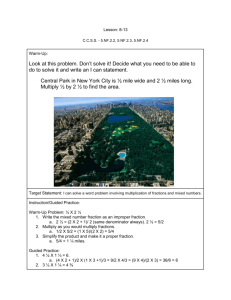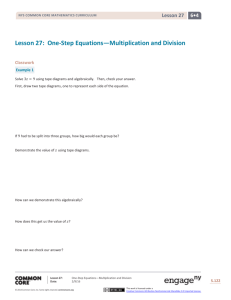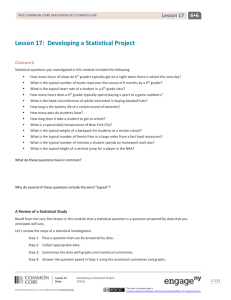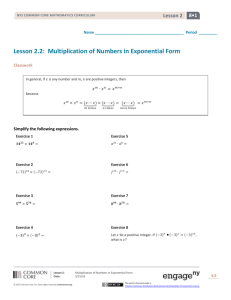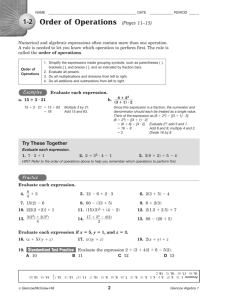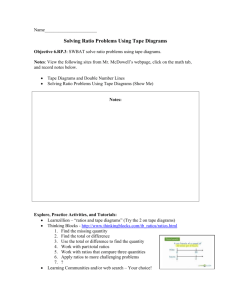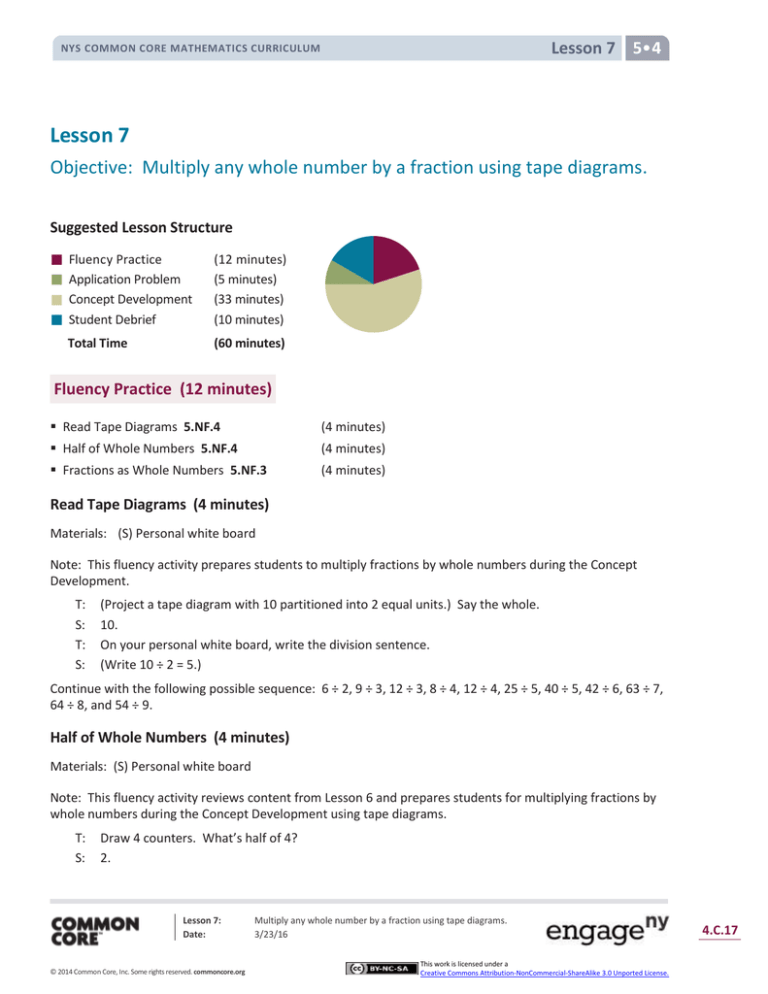
Lesson 7 5
NYS COMMON CORE MATHEMATICS CURRICULUM
Lesson 7
Objective: Multiply any whole number by a fraction using tape diagrams.
Suggested Lesson Structure
Fluency Practice
Application Problem
Concept Development
Student Debrief
Total Time
(12 minutes)
(5 minutes)
(33 minutes)
(10 minutes)
(60 minutes)
Fluency Practice (12 minutes)
Read Tape Diagrams 5.NF.4
(4 minutes)
Half of Whole Numbers 5.NF.4
(4 minutes)
Fractions as Whole Numbers 5.NF.3
(4 minutes)
Read Tape Diagrams (4 minutes)
Materials: (S) Personal white board
Note: This fluency activity prepares students to multiply fractions by whole numbers during the Concept
Development.
T:
S:
T:
S:
(Project a tape diagram with 10 partitioned into 2 equal units.) Say the whole.
10.
On your personal white board, write the division sentence.
(Write 10 ÷ 2 = 5.)
Continue with the following possible sequence: 6 ÷ 2, 9 ÷ 3, 12 ÷ 3, 8 ÷ 4, 12 ÷ 4, 25 ÷ 5, 40 ÷ 5, 42 ÷ 6, 63 ÷ 7,
64 ÷ 8, and 54 ÷ 9.
Half of Whole Numbers (4 minutes)
Materials: (S) Personal white board
Note: This fluency activity reviews content from Lesson 6 and prepares students for multiplying fractions by
whole numbers during the Concept Development using tape diagrams.
T:
S:
Draw 4 counters. What’s half of 4?
2.
Lesson 7:
Date:
© 2014 Common Core, Inc. Some rights reserved. commoncore.org
Multiply any whole number by a fraction using tape diagrams.
3/23/16
This work is licensed under a
Creative Commons Attribution-NonCommercial-ShareAlike 3.0 Unported License.
4.C.17
Lesson 7 5
NYS COMMON CORE MATHEMATICS CURRICULUM
1
T:
(Write 2 of 4 = 2.) Say a division sentence that helps you find the answer.
S:
4 ÷ 2 = 2.
Continue with the following possible sequence: 1 half of 10, 1 half of 8, 1 half of 30, 1 half of 54, 1 fourth of
20, 1 fourth of 16, 1 third of 9, and 1 third of 18.
Fractions as Whole Numbers (4 minutes)
Materials: (S) Personal white board
Note: This fluency activity reviews Lesson 5, as well as denominators that are equivalent to hundredths.
Instruct students to use their personal white boards for calculations that they cannot do mentally.
T:
S:
I’ll say a fraction. You say it as a division problem. 4 halves.
4 ÷ 2 = 2.
Continue with the following possible suggestions:
6 14 54 40 80 180 960 10 15 35 85 100 150 300 900 8 12 24 96 50 75
, , , , ,
,
, , , , ,
,
,
,
, , , , , , , and
2 2 2 20 20 20 20 5 5 5 5 50 50 50 50 4 4 4 4 25 25
800
.
25
Application Problem (5 minutes)
Mr. Peterson bought a case (24 boxes) of fruit juice.
One-third of the drinks were grape, and two-thirds were
cranberry. How many boxes of each flavor did Mr. Peterson
buy? Show your work using a tape diagram or an array.
Note: This Application Problem requires students to use
skills explored in Lesson 6. Students are finding fractions of
a set and showing their thinking with models.
Concept Development (33 minutes)
NOTES ON
MULTIPLE MEANS
OF REPRESENTATION:
Materials: (S) Personal white board
Problem 1
3
5
What is of 35?
T:
T:
3
(Write 5 of 35 = ___ on the board.) We used two
different models (counters and arrays) yesterday to
find fractions of sets. We will use tape diagrams to
help us today.
We must find 3 fifths of 35. Draw a bar to represent
our whole. What’s our whole?
Lesson 7:
Date:
© 2014 Common Core, Inc. Some rights reserved. commoncore.org
Please note that, throughout the
lesson, division sentences are written
as fractions to reinforce the
interpretation of a fraction as division.
When reading the fraction notation,
the language of division should be
used. For example, in Problem 1,
1 unit =
35
5
should be read as 1 unit
equals 35 divided by 5.
Multiply any whole number by a fraction using tape diagrams.
3/23/16
This work is licensed under a
Creative Commons Attribution-NonCommercial-ShareAlike 3.0 Unported License.
4.C.18
Lesson 7 5
NYS COMMON CORE MATHEMATICS CURRICULUM
S:
T:
S:
T:
S:
T:
S:
T:
S:
T:
S:
T:
S:
(Draw.) 35.
(Draw a bar and label it as 35.) How many units
should we cut the whole into?
5.
How do you know?
The denominator tells us we want fifths. That is
the unit being named by the fraction. We are
asked about fifths, so we know we need 5 equal
parts.
Divide your bar into fifths.
(Work.)
(Cut the bar into 5 equal units.) We know 5 units are equal to 35. How do we find the value of 1
unit? Say the division sentence.
35 ÷ 5 = 7.
(Write 5 units = 35, 1 unit = 35 ÷ 5 = 7.) Have we
NOTES ON
answered our question?
MULTIPLE MEANS
No, we found 1 unit is equal to 7, but the question is to
OF ACTION AND
find 3 units. We need 3 fifths. When we divide by
EXPRESSION:
5, that’s just 1 fifth of 35.
Students with fine motor deficits may
How will we find 3 units?
find drawing tape diagrams difficult.
Multiply 3 and 7 to get 21. We could add 7 + 7 + 7.
Graph paper may provide some
We could put 3 of the 1 fifths together. That would
support. Online sources, such as the
be 21.
Thinking Blocks website, may also be
helpful.
3
T:
What is 5 of 35?
S:
21.
Problem 2
3
Aurelia buys 2 dozen roses. Of these roses, 4 are red, and the
rest are white. How many white roses did she buy?
T:
What do you know about this problem? Turn and
share with your partner.
S:
I know the whole is 2 dozen, which is 24. 4 are
3
1
T:
red roses, and 4 are white roses. The total is 24
roses. The information in the problem is about
red roses, but the question is about the other part—
the white roses.
Discuss with your partner how you’ll solve this
problem.
Lesson 7:
Date:
© 2014 Common Core, Inc. Some rights reserved. commoncore.org
Multiply any whole number by a fraction using tape diagrams.
3/23/16
This work is licensed under a
Creative Commons Attribution-NonCommercial-ShareAlike 3.0 Unported License.
4.C.19
Lesson 7 5
NYS COMMON CORE MATHEMATICS CURRICULUM
S:
We can first find the total red roses, and then subtract from 24 to get the white roses. Since I
1
1
know of the whole is white roses, I can find of 24 to find the white roses. That’s faster.
4
T:
S:
T:
S:
4
Work with a partner to draw a tape diagram and solve.
(Work.)
Answer the question for this problem.
She bought 6 white roses.
Problem 3
Rosie had 17 yards of fabric. She used one-third of it to
make a quilt. How many yards of fabric did Rosie use
for the quilt?
T:
T:
S:
T:
S:
T:
What can you draw? Turn and share with your
partner.
Compare this problem to the others we’ve done today.
The answer is not a whole number. The quotient is
not a whole number. We were still looking for
fractional parts, but the answer isn’t a whole number.
We can draw a bar that shows 17 and divide it into
thirds. How do we find the value of one unit?
Divide 17 by 3.
How much fabric is one-third of 17 yards?
S:
17
3
2
3
T
How would you find 2 thirds of 17?
S:
Double 5 . Multiply 5 times 2.
yards. 5 yards.
2
3
2
3
2
Subtract 5 3 from 17.
2
Repeat this sequence with 5 of 11, if necessary.
Problem 4
2
3
NOTES ON
MULTIPLE MEANS
OF REPRESENTATION:
The added complexity of finding a
fraction of a quantity that is not a
multiple of the denominator may
require a return to concrete materials
for some students. Allow them access
to materials that can be folded and cut
to model Problem 3 physically. Five
whole squares can be distributed into
each unit of 1 third. Then, the
remaining whole squares can be cut
into thirds and distributed among the
units of thirds. Be sure to make the
connection to the fraction form of the
division sentence and the written
recording of the division algorithm.
of a number is 8. What is the number?
T:
S:
How is this problem different from the ones we
just solved?
In the first problem, we knew the total and wanted
to find a part of it. In this one, we know how much
2 thirds is, but not the whole. Last time, they
told us the whole and asked us about a part. This
time, they told us about a part and asked us to find
the whole.
Lesson 7:
Date:
© 2014 Common Core, Inc. Some rights reserved. commoncore.org
Multiply any whole number by a fraction using tape diagrams.
3/23/16
This work is licensed under a
Creative Commons Attribution-NonCommercial-ShareAlike 3.0 Unported License.
4.C.20
Lesson 7 5
NYS COMMON CORE MATHEMATICS CURRICULUM
T:
S:
T:
S:
T:
S:
T:
S:
T:
S:
T:
S:
T:
S:
T:
Draw a bar to represent the whole. What kind of units will we need to divide the whole into?
(Draw.) Thirds.
(Draw the bar divided into thirds.) What else do we know? Turn and tell your partner.
We know that 2 thirds is the same as 8, so it means we can label 2 of the units with a bracket and 8.
The units are thirds. We know about 2 of them. They are equal to 8 together. We don’t know
what the whole bar is worth, so we have to put a question mark there.
(Draw to show the labeling.) Label your bars.
(Label their bars.)
How can knowing what 2 units are worth help us find the whole?
Since we know that 2 units = 8, we can divide to find that 1 unit is equal to 4.
(Write 1 unit = 8 ÷ 2 = 4.) Let’s record 4 inside each unit. (Show the recording.)
(Record the 4 inside each unit.)
Can we find the whole now?
Yes. We can add 4 + 4 + 4 =12. We can multiply 3 times 4, which is equal to 12.
(Write 3 units = 3 × 4 = 12.) Answer the question for this problem.
The number is 12.
2
Let’s think about it and check to see if it makes sense. (Write of 12 = 8.) Work independently on
3
your personal white board, and solve to find what 2 thirds of 12 is.
Problem 5
4
Tiffany spent 7 of her money on a teddy bear. If the teddy bear cost $24, how much money did she have at
first?
T:
S:
T:
S:
T:
S:
T:
S:
T:
S:
Which problem that we’ve worked on
today is most similar to this one?
This one is just like Problem 4. We have
information about a part, and we have to
find the whole.
What can you draw? Turn and share with
your partner.
We can draw a bar for all of the money. We can show what the teddy bear costs. It costs $24, and
4
it’s 7 of her total money. We can put a question mark over the whole bar.
Do we have enough information to find the value of 1 unit?
Yes.
How much is one unit?
4 units = $24, so 1 unit = $6.
How will we find the amount of money she had at first?
Multiply $6 by 7.
Lesson 7:
Date:
© 2014 Common Core, Inc. Some rights reserved. commoncore.org
Multiply any whole number by a fraction using tape diagrams.
3/23/16
This work is licensed under a
Creative Commons Attribution-NonCommercial-ShareAlike 3.0 Unported License.
4.C.21
Lesson 7 5
NYS COMMON CORE MATHEMATICS CURRICULUM
T:
S:
T:
S:
Say the multiplication sentence, starting with 7.
7 × $6 = $42.
Answer the question in this problem.
Tiffany had $42 at first.
Problem Set (10 minutes)
Students should do their personal best to complete the
Problem Set within the allotted 10 minutes. For some
classes, it may be appropriate to modify the assignment by
specifying which problems they work on first. Some
problems do not specify a method for solving. Students
should solve these problems using the RDW approach
used for Application Problems.
Student Debrief (10 minutes)
Lesson Objective: Multiply any whole number by a
fraction using tape diagrams.
The Student Debrief is intended to invite reflection and
active processing of the total lesson experience.
Invite students to review their solutions for the Problem
Set. They should check work by comparing answers with a
partner before going over answers as a class. Look for
misconceptions or misunderstandings that can be
addressed in the Debrief. Guide students in a conversation
to debrief the Problem Set and process the lesson.
You may choose to use any combination of the questions
below to lead the discussion.
What pattern relationships did you notice
between Problems 1(a) and 1(b)? (The whole of
36 is twice as much as the whole of 18. 1 third of
36 is twice as much as 1 third of 18. 12 is twice as
much as 6.)
What pattern did you notice between Problems
1(c) and 1(d)? (The wholes are the same. The
fraction of 3 eighths is half of 3 fourths. That is
why the answer of 9 is also half of 18.)
Look at Problems 1(e) and 1(f). We know that 4
fifths and 1 seventh aren’t equal, so how did we
get the same answer?
Lesson 7:
Date:
© 2014 Common Core, Inc. Some rights reserved. commoncore.org
Multiply any whole number by a fraction using tape diagrams.
3/23/16
This work is licensed under a
Creative Commons Attribution-NonCommercial-ShareAlike 3.0 Unported License.
4.C.22
Lesson 7 5
NYS COMMON CORE MATHEMATICS CURRICULUM
Compare Problems 1(c) and 1(j). How are they similar, and how are they different? (The questions
involve the same numbers, but in Problem 1(c), 3 fourths is the unknown quantity, and in Problem
1(j), it is the known quantity. In Problem 1(c), the whole is known, but in Problem 1(j), the whole is
unknown.)
How did you solve for Problem 2(b)? Explain your strategy or solution to a partner.
There are a couple of different methods to solve Problem 2(c). Find someone who used a different
approach from yours and explain your thinking.
Exit Ticket (3 minutes)
After the Student Debrief, instruct students to complete the Exit Ticket. A review of their work will help you
assess the students’ understanding of the concepts that were presented in the lesson today and plan more
effectively for future lessons. You may read the questions aloud to the students.
Lesson 7:
Date:
© 2014 Common Core, Inc. Some rights reserved. commoncore.org
Multiply any whole number by a fraction using tape diagrams.
3/23/16
This work is licensed under a
Creative Commons Attribution-NonCommercial-ShareAlike 3.0 Unported License.
4.C.23
Lesson 7 Problem Set 5
NYS COMMON CORE MATHEMATICS CURRICULUM
Name
Date
1. Solve using a tape diagram.
a.
1
3
of 18
b.
1
3
of 36
c.
3
4
× 24
d.
3
8
× 24
e.
4
5
× 25
f.
1
7
× 140
g.
1
4
×9
h.
2
5
× 12
of a number is 10. What’s the number?
j.
3
4
of a number is 24. What’s the number?
i.
2
3
Lesson 7:
Date:
© 2014 Common Core, Inc. Some rights reserved. commoncore.org
Multiply any whole number by a fraction using tape diagrams.
3/23/16
This work is licensed under a
Creative Commons Attribution-NonCommercial-ShareAlike 3.0 Unported License.
4.C.24
NYS COMMON CORE MATHEMATICS CURRICULUM
Lesson 7 Problem Set 5
2. Solve using tape diagrams.
a. There are 48 students going on a field trip. One-fourth are girls. How many boys are going on the
trip?
3
b. Three angles are labeled below with arcs. The smallest angle is as large as the 160° angle. Find the
8
value of angle a.
5
c. Abbie spent 8 of her money and saved the rest. If she spent $45, how much money did she have at
first?
2
d. Mrs. Harrison used 16 ounces of dark chocolate while baking. She used 5 of the chocolate to make
some frosting and used the rest to make brownies. How much more chocolate did Mrs. Harrison use
in the brownies than in the frosting?
Lesson 7:
Date:
© 2014 Common Core, Inc. Some rights reserved. commoncore.org
Multiply any whole number by a fraction using tape diagrams.
3/23/16
This work is licensed under a
Creative Commons Attribution-NonCommercial-ShareAlike 3.0 Unported License.
4.C.25
Lesson 7 Exit Ticket 5
NYS COMMON CORE MATHEMATICS CURRICULUM
Name
Date
Solve using a tape diagram.
a.
3
5
of 30
b.
3
5
of a number is 30. What’s the number?
c. Mrs. Johnson baked 2 dozen cookies. Two-thirds of the cookies were oatmeal. How many oatmeal
cookies did Mrs. Johnson bake?
Lesson 7:
Date:
© 2014 Common Core, Inc. Some rights reserved. commoncore.org
Multiply any whole number by a fraction using tape diagrams.
3/23/16
This work is licensed under a
Creative Commons Attribution-NonCommercial-ShareAlike 3.0 Unported License.
4.C.26
Lesson 7 Homework 5
NYS COMMON CORE MATHEMATICS CURRICULUM
Name
Date
1. Solve using a tape diagram.
a.
1
4
of 24
b.
1
4
of 48
c.
2
3
× 18
d.
2
6
× 18
e.
3
7
× 49
f.
3
10
g.
1
3
× 31
h.
2
5
× 120
× 20
i.
1
4
× 25
j.
3
4
× 25
k.
3
4
of a number is 27. What’s the number?
l.
2
5
of a number is 14. What’s the number?
Lesson 7:
Date:
© 2014 Common Core, Inc. Some rights reserved. commoncore.org
Multiply any whole number by a fraction using tape diagrams.
3/23/16
This work is licensed under a
Creative Commons Attribution-NonCommercial-ShareAlike 3.0 Unported License.
4.C.27
Lesson 7 Homework 5
NYS COMMON CORE MATHEMATICS CURRICULUM
2. Solve using tape diagrams.
2
a. A skating rink sold 66 tickets. Of these, were children’s tickets, and the rest were adult tickets. What
3
total number of adult tickets were sold?
1
b. A straight angle is split into two smaller angles as shown. The smaller angle’s measure is 6 that of a
straight angle. What is the value of angle a?
5
c. Annabel and Eric made 17 ounces of pizza dough. They used of the dough to make a pizza and used
8
the rest to make calzones. What is the difference between the amount of dough they used to make
pizza, and the amount of dough they used to make calzones?
3
4
d. The New York Rangers hockey team won of their games last season. If they lost 21 games, how
many games did they play in the entire season?
Lesson 7:
Date:
© 2014 Common Core, Inc. Some rights reserved. commoncore.org
Multiply any whole number by a fraction using tape diagrams.
3/23/16
This work is licensed under a
Creative Commons Attribution-NonCommercial-ShareAlike 3.0 Unported License.
4.C.28


